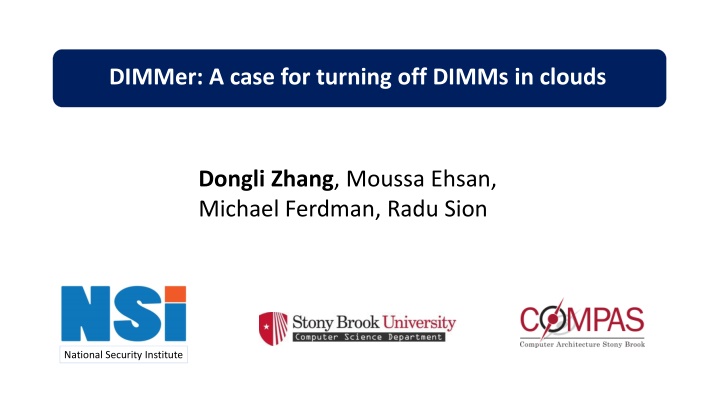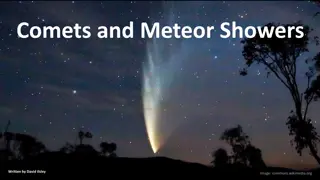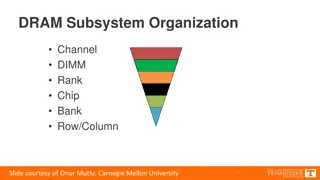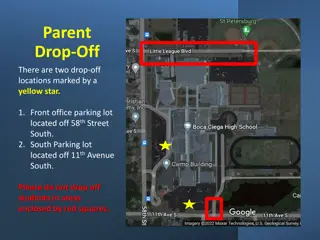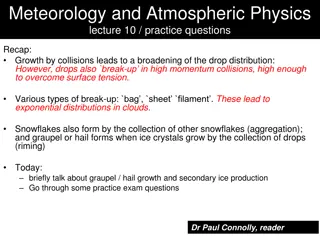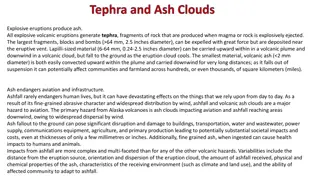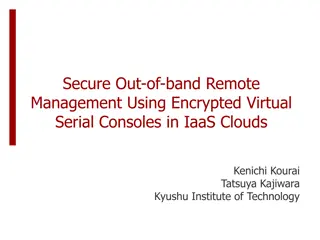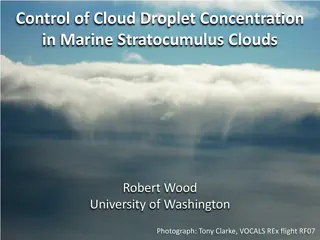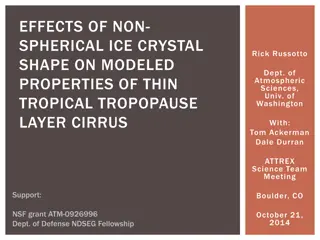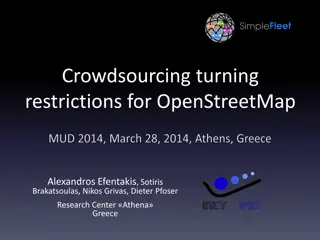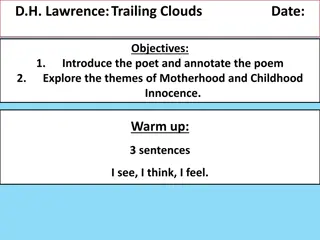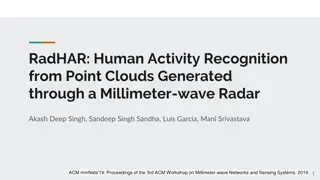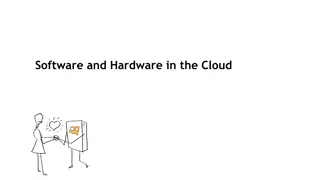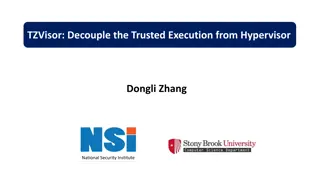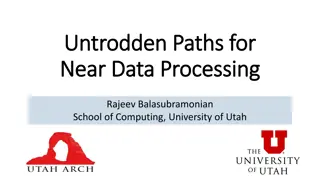DIMMer: A case for turning off DIMMs in clouds Dongli Zhang
In this study, researchers propose DIMMer, a framework aimed at reducing energy waste in cloud environments by dynamically turning off DIMMs during low workloads. The vision includes agile workload-driven scalability, power reduction strategies such as powering off idle DRAM ranks and CPU sockets, and modifications to the OS kernel and hardware for optimized power management. By implementing DIMMer, a significant reduction in energy consumption and improved efficiency can be achieved in cloud data centers.
Download Presentation

Please find below an Image/Link to download the presentation.
The content on the website is provided AS IS for your information and personal use only. It may not be sold, licensed, or shared on other websites without obtaining consent from the author.If you encounter any issues during the download, it is possible that the publisher has removed the file from their server.
You are allowed to download the files provided on this website for personal or commercial use, subject to the condition that they are used lawfully. All files are the property of their respective owners.
The content on the website is provided AS IS for your information and personal use only. It may not be sold, licensed, or shared on other websites without obtaining consent from the author.
E N D
Presentation Transcript
DIMMer: A case for turning off DIMMs in clouds Dongli Zhang, Moussa Ehsan, Michael Ferdman, Radu Sion National Security Institute
Inconsistency between Capacity and Demand 200B KWh worldwide in 2010 Year 2011 Capacity >>> demand Energy waste is 90% 200,000 The New York Times 2012 Stony Brook Network Security and Applied Cryptography Laboratory @ SoCC 2014 February 28, 2025 2 National Security Institute
Google Data Center Peak Power Usage Distribution 2007 2012 [The Datacenter as a Computer: An Introduction to the Design of Warehouse-Scale Machines] [The Datacenter as a Computer: An Introduction to the Design of Warehouse-Scale Machines, second edition] Stony Brook Network Security and Applied Cryptography Laboratory @ SoCC 2014 February 28, 2025 3 National Security Institute
DIMMer Vision Agile framework Workload-driven scalability and power reduction Power off idle DRAM ranks Power off idle CPU sockets Save background power Stony Brook Network Security and Applied Cryptography Laboratory @ SoCC 2014 February 28, 2025 4 National Security Institute
Vision for Implementation Modifications to the OS kernel (e.g., Linux) and Hardware: Rank-Aware Page Allocator Create a free list for each DRAM rank Page Migrator Migrate pages in the background and at low priority Expose registers in CPU and DRAM controller To allow full electronically power-off Provided by hardware manufacturer Enable DIMMer during low workload Stony Brook Network Security and Applied Cryptography Laboratory @ SoCC 2014 February 28, 2025 5 National Security Institute
DRAM: Self-Refresh Mode Low-power mode Consumes less energy than ACT mode Data is not lost State of the Art: Hot ranks and cold ranks Maximize the self-refresh time Idle 8GB DIMM power = 2.3W ! Self-Refresh: Reduce Active Time DIMMer: Reduce Active Capacity Stony Brook Network Security and Applied Cryptography Laboratory @ SoCC 2014 February 28, 2025 6 National Security Institute
DIMMer vs. Self-Refresh CPU+DRAM Power: Self-Refresh : 66.00W DIMMer : 64.16W Percentage of Time in ACT_STBY/PRE_STBY: Active 100% Idle 0% Stony Brook Network Security and Applied Cryptography Laboratory @ SoCC 2014 February 28, 2025 7 National Security Institute
DIMMer vs. Self-Refresh Idle CPU socket power = 16W CPU+DRAM Power: Self-Refresh : 57.12W DIMMer : 37.44W Percentage of Time in ACT_STBY/PRE_STBY: Active 100% Idle 0% Stony Brook Network Security and Applied Cryptography Laboratory @ SoCC 2014 February 28, 2025 8 National Security Institute
Google Cluster Trace http://code.google.com/p/googleclusterdata/ 12000+ servers Machines, jobs, and tasks Workload traces (CPU, memory, storage) with normalized data Resource usage in 5-min granularity of one month Spawned a number of seminal results SoCC , ICDCS, ICAC, IC2E Stony Brook Network Security and Applied Cryptography Laboratory @ SoCC 2014 February 28, 2025 9 National Security Institute
Our Assumptions Max server DRAM capacity = 64GB Max server CPU socket = 2 No OS kernel resource usage and job dependencies Increasing DRAM capacity in data center Stony Brook Network Security and Applied Cryptography Laboratory @ SoCC 2014 February 28, 2025 10 National Security Institute
Saving: DRAM Consolidate memory pages on minimum DRAM ranks on each server Monthly DRAM Rank Count (total and idle) 50% memory utilization 50% DRAM ranks are idle Save 30MWh per month Stony Brook Network Security and Applied Cryptography Laboratory @ SoCC 2014 February 28, 2025 11 National Security Institute
Saving: CPU Consolidate workloads on minimum CPU sockets on each server Monthly CPU socket count (total and idle) 50 % CPU utilization 20 % CPU sockets are idle No PCI devices (e.g. NIC) involved Save 52MWh per month + = 82MWh = 51MT CO2 Stony Brook Network Security and Applied Cryptography Laboratory @ SoCC 2014 February 28, 2025 12 National Security Institute
DIMMer Cost The story is not finished OS Memory Capacity Resizing Non-Interleaved Address Mapping Page Migration Reduced Cache Capacity Physical Memory Address Space 4KB Page Addition Removal Disk Cache Stony Brook Network Security and Applied Cryptography Laboratory @ SoCC 2014 February 28, 2025 13 National Security Institute
Page Migration 8GB node-to-node migration takes 13.5s Observation in Google Cluster Trace 30.2% are cache pages 11.2% are caches pages not mapped into process Tricks: Only migrate hot cache pages and anonymous pages Out of band migration 4KB Page Stony Brook Network Security and Applied Cryptography Laboratory @ SoCC 2014 February 28, 2025 14 National Security Institute
OS Memory Capacity Resizing Liu et al. (TPDS 2014) Coarse-grained VM memory hotplug Dell PowerEdge 1950 & Intel Quad-Core Xeon E5450 3GHz VM-based 1GB Memory Removal VM-based 1GB Memory Addition Physical Memory Address Space 0.43s 0.3s Heavily loaded running TPC-C Tricks: Reserve extra DRAM rank to handle spontaneous demand spikes Stony Brook Network Security and Applied Cryptography Laboratory @ SoCC 2014 February 28, 2025 15 National Security Institute
Reduced Cache Capacity Web Server Disk Cache Zhu et al. (HotCloud 2012) Sacrificing a few percent cache hit rate Reduce cache cost by 90% Tricks: Hot cache pages on active rank Cold cache pages on idle rank Disk Cache Stony Brook Network Security and Applied Cryptography Laboratory @ SoCC 2014 February 28, 2025 16 National Security Institute
Non-Interleaved Address Mapping Channel Interleaving Ferdman et al. (ASPLOS 2012): Cloud workloads underutilize memory bandwidth Map-Reduce Web front end 25% of available bandwidth Media Streaming Web Search Rank Interleaving VipZonE (CODES+ISSS 2012): 1.03% execution overhead Tricks: Reserve certain interleaving-enabled channels Power off parallel ranks across channels Stony Brook Network Security and Applied Cryptography Laboratory @ SoCC 2014 February 28, 2025 17 National Security Institute
Total Cost of Ownership (TCO) Model by James Hamilton : http://perspectives.mvdirona.com/ Cost of power: $0.10/KWh Cost of facility: $50M Number of servers: 12,583 Cost/Server: $2K Server Amortization: 36 months Power Usage Effectiveness: 1.2 Monthly Savings Over Total: 0.6% Over Power: 1.4% Excluding Cooling: 3.15% 5.1% 18.1% 0.6% 53.2% Servers Cooling Infrastructure DIMMer's Savings Power Other Infrastructure 23.0% Stony Brook Network Security and Applied Cryptography Laboratory @ SoCC 2014 February 28, 2025 18 National Security Institute
DIMMer Summary DIMMer Vision: Power off idle DRAM and CPU Vision for Implementation Improvement over Self-Refresh Benefit / Cost 50% DRAM and 18.8% CPU background energy Total Cost of Ownership Energy-efficient scheduler in the future Dongli Zhang Doctoral Student @ Stony Brook University Email: dozhang@cs.stonybrook.edu Stony Brook Network Security and Applied Cryptography Laboratory @ SoCC 2014 February 28, 2025 19 National Security Institute
